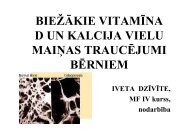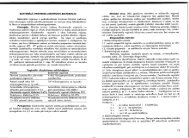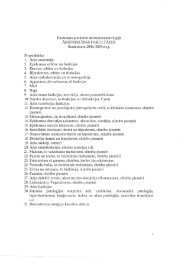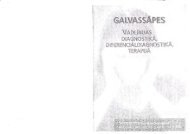PHYSICS
n - susliks.lv
n - susliks.lv
- No tags were found...
Create successful ePaper yourself
Turn your PDF publications into a flip-book with our unique Google optimized e-Paper software.
the surface temperature (Tsar[) is 3SoC, the temperature of the air (T a)<br />
is 20"C, and the ambient wind speed (V) is SO em-s:".<br />
Solution. The average of the boundary layer (8 ) is:<br />
8 = 5 8· {D = 5 8 . JO,6 = 5 mm = 5 .10- 3 m<br />
, 'Ii~ ' 0,8<br />
Using Equation (13.6) and k , ai<br />
(0.0257 W·m-I·K-I at 20"C), calculate<br />
the heat flux density conducted across the boundary layer.<br />
(T,arj - Ta;r ) _ 0,0257· (38 - 20) = 93 W . m-2<br />
J c = - 2k air [ r + 8 ) - [ 0,3 + 0,005 J<br />
rln - 0,3·ln 03<br />
r ,<br />
13.3.3. Radiation<br />
Two bodies at different temperatures will exchange heat even<br />
when there is no possibility of exchange by conduction or<br />
convection; the transfer of heat takes place by radiation.<br />
The rate at which an object emits radiant energy is proportional<br />
to the fourth power of its absolute temperature. This is<br />
known as Stefan-Boltzmann's law which is expressed in equation<br />
form as:<br />
R = aSET4 (13.7)<br />
where R is the power radiated by the body (W); (J =5,67051'10- 8<br />
W·m- 2 •K-4 is a constant; S is the surface area of the object, EO is a<br />
constant called the emissivity, and T is the temperature in Kelvin.<br />
When an object is in equilibrium with its surrounding, it<br />
radiates and absorbs energy at the same time:<br />
R = Q - Q = Sa(aT4 - ET41 (13.8)<br />
n a e s e/<br />
where a is a constant called the absorptivity.<br />
The values of constants a and EO are given in Table 13.3.<br />
Example. If a brown cow has an effective radiant-surface area of 4 m'<br />
and a radiant-surface temperature averaging 27"C, and the average<br />
temperature of the environment is -3°C, calculate the net flux of<br />
thermal radiant energy between an animal and its environment.<br />
104<br />
13.3. Radiation absorptivity and emissivity ratios for various<br />
farm-animals and humans<br />
Object I Absorptivity, a r Emissivity, EO<br />
Cow<br />
white 0.50 0.95<br />
brown 0.80 0.95<br />
black 0.90 0.95<br />
Pig<br />
white 0.50 0.95<br />
black 0.90 0.95<br />
Sheep<br />
without wool 0.60 0.95<br />
with wool 0.75 0.95<br />
Human organism 0.65 - O.SO 0.95<br />
Solution. A net heat flux from animal to environment via thermal<br />
radiation can be determined from Equation ( 13.S ):<br />
R n<br />
= Q a<br />
- Q, = Sa (aT/ - ET,4) =<br />
= 4 m2·5,67051·10-8 W·m- 2. K-4(0.SO·300 4 - 0.95'270 4) = 632 W.<br />
13.3.4. Evaporation<br />
Evaporative loss of water is an excellent way for animals to<br />
dissi pate heat. The rate of evaporation depends not only on the<br />
surface temperature, but also on the difference in water vapor<br />
density between the animal's surface and the environment, and<br />
on the resistance to water loss from the surface. Typical values<br />
for evaporative water loss are 7.0 - 20.9 W·m- 2 •<br />
Chapter 14. THERMOBIOLOGY<br />
~~,~~,;;,."~;;;.;;:.;






